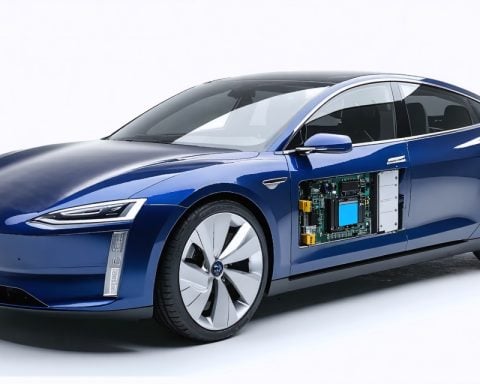As electric vehicles (EVs) become increasingly popular, a new issue has emerged in discussions about their future: fire risks associated with their batteries. While EVs are often praised for their eco-friendly benefits, experts are now urging a closer look at potential safety hazards.
The Science Behind the Sparks
The primary concern lies in the lithium-ion batteries, which are known for their volatility. Although incidents of EV fires have been relatively rare, when they do occur, they are significantly more challenging to extinguish compared to traditional gasoline-fueled car fires. This complexity arises from the potential for thermal runaway, a chain reaction leading to fire when battery cells become overheated or damaged.
Future Proofing with Technology
Automakers and technologists are actively researching solutions to mitigate these risks. One promising avenue is the development of solid-state batteries, which are less likely to overheat than their liquid counterparts. Companies are also creating more sophisticated cooling systems and protective casings to further enhance safety.
Regulatory and Educational Measures
Regulators worldwide are stepping up efforts to establish stringent safety standards for EV batteries. Coupled with this, there’s a push for educational initiatives targeted at emergency responders. These programs aim to better equip first responders with the knowledge needed to handle EV-related fires safely.
As the adoption of electric vehicles accelerates, addressing these safety challenges will be crucial. Continuous innovation combined with strong regulatory frameworks and education can pave the way for a safer, sustainable future on the road.
Electrifying Safety: Navigating the Future of Electric Vehicle Fire Risks
The rise of electric vehicles (EVs) is heralded as a pivotal move towards reducing humanity’s carbon footprint and tackling climate change. Yet, the underlying concern surrounding the fire risks associated with these vehicles’ lithium-ion batteries introduces a multifaceted challenge that impacts the environment, humanity, and the global economy.
Environmental Impact
From an environmental perspective, while EVs present a cleaner alternative to traditional vehicles by reducing greenhouse gas emissions, the fire risk associated with their batteries poses unique environmental hazards. When lithium-ion batteries catch fire, they release toxic gases and pollutants into the atmosphere, which can negatively impact air quality. This scenario underscores the importance of developing robust battery technologies that minimize the likelihood of fires and the subsequent environmental fallout.
Impact on Humanity
For humanity, the potential safety hazards of EV fires necessitate a reevaluation of emergency response protocols. Traditional firefighting techniques may be inadequate for addressing the unique challenges posed by battery fires, necessitating a reevaluation of emergency response approaches. The push for educational initiatives aimed at training first responders serves as a crucial step in safeguarding communities and ensuring the safe adoption of EVs on a larger scale.
Economic Considerations
On an economic level, the transition towards EVs is stimulating innovation and technological advancements. Companies investing in solid-state batteries and advanced cooling systems seek to capture a share of the burgeoning EV market. These innovations not only address safety concerns but also drive economic growth through the development of new technologies and job creation. Moreover, regulatory frameworks mandating stricter safety standards could foster a competitive advantage for firms that prioritize safety and innovation.
A Glimpse into the Future
The integration of safer battery technologies and robust safety frameworks holds significant implications for the future of humanity. As EVs become more prevalent, they will play a crucial role in reducing carbon emissions, thereby combating climate change and contributing to a healthier planet. Furthermore, the improvements in battery safety and emergency response could set a precedent for the development and regulation of other emerging technologies.
Ultimately, addressing the fire risks associated with EV batteries will require a commitment to continuous innovation, collaboration between industry stakeholders, and the establishment of comprehensive safety standards. By doing so, society can harness the full potential of electric vehicles, driving forward a future that is both environmentally sustainable and technologically advanced.
Unveiling Hidden Challenges: The Fire Risks of Electric Vehicles
As the popularity of electric vehicles (EVs) rises, there is an emerging concern about the fire risks associated with their batteries. While the environmental benefits of EVs are widely acknowledged, there is an increasing need to address the associated safety challenges comprehensively.
Innovations in Battery Technology
Continued advancements in battery technology hold promise for reducing EV fire risks. Companies are exploring next-generation innovations that go beyond solid-state batteries. For instance, lithium-metal batteries, characterized by their higher energy density, could offer more efficiency and safety. The use of advanced materials and nanotechnology is being investigated to enhance battery stability and prevent overheating.
Enhanced Safety Features and Systems
Manufacturers are integrating advanced safety features into EV designs. Systems like Battery Management Systems (BMS) are being optimized to continually monitor battery health and performance. These systems can preemptively identify potential issues and alert drivers, reducing the likelihood of mishaps.
Another innovative approach is the incorporation of thermal management systems. These systems are being designed to manage heat distribution within the battery pack, minimizing the risk of thermal runaway, which is a key contributor to battery fires.
Pros and Cons: Weighing the Factors
Pros:
– Eco-Friendliness: EVs significantly reduce carbon emissions compared to conventional vehicles.
– Efficiency Gains: Ongoing improvements in battery technology could lead to longer driving ranges and shorter charging times.
Cons:
– Safety Concerns: The potential for battery fires, although rare, remains a critical issue that needs addressing.
– High Initial Costs: Advanced safety technologies and new battery types may lead to higher upfront costs for consumers.
Regulatory Focus and Global Trends
Globally, regulatory bodies are implementing comprehensive standards to guide the development and safety assurance of EV batteries. Countries are looking towards collaborative frameworks to establish uniform safety protocols and foster cross-border knowledge sharing.
As the technology evolves, there is a clear trend towards creating international alliances aimed at standardizing EV safety regulations and practices. This momentum is expected to play a pivotal role in boosting consumer confidence and accelerating EV adoption globally.
Predicting the Road Ahead
The convergence of regulatory frameworks, technological innovation, and industry collaboration signals a promising trajectory for electric vehicles. As the sector evolves, industry experts predict that a holistic approach that encompasses improved battery technology, stringent safety standards, and ongoing education will be imperative.
In summary, while EVs bring environmental advantages, addressing safety weaknesses is paramount. By marrying technological innovations with robust regulatory oversight, the EV industry can navigate these challenges effectively, ensuring a safer, more sustainable future for all.
For more insights on electric vehicles and safety trends, visit Tesla.













